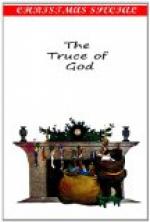The American novelist, like the Italian Manzoni, teaches the lesson inculcated in “The Betrothed” ("I Promessi Sposi"). It is a lesson of forgiveness. It is noblest to forgive. Forgiveness is divine. Forgive seventy times seventy times, again and again. In Manzoni’s story, the saintly Frederick Borromeo preaches and acts that sublime lesson in his scene with the Innominato with compelling eloquence. In “The Truce of God,” the Lady Margaret, the monk Omehr, the very woes of the Houses of Hers and Stramen, the tragic madness of the unfortunate Bertha, the blood shed in a senseless and passionate quarrel, the bells of the sanctuary bidding the warring factions sheathe the sword, incessantly proclaim the same duty. In writing his story, George Henry Miles was not only painting for us a picture aglow with the life of olden times, but pointing out in a masterly way, the historic role of the Church in molding the manners of an entire generation.
The reader of “The Truce of God,” in spite of the fact that the romance seems to be sketched only in its broadest outlines, gets a distinct knowledge of its chief actors. They live before his eyes. De Hers and Stramen are not mere abstractions. They have the rugged, clear-cut character, the sudden passions, the quick and at times dangerous and savage impulses of the men of the eleventh century. In them the barbarian has not yet been completely tamed. But neither has he been given full rein. Somewhere in these hearts, there lurks a sentiment of honor, of knighthood, which the Church of Christ has ennobled, and to which the helpless and the innocent do not appeal in vain.
The American has caught this sentiment and plays upon it skillfully. His setting is in keeping with his story. The wandering minstrel, the turreted castle, the festive board, the high-vaulted hall with its oaken rafters, the chase, the wide reaches of the forests of Franconia, the beetling ramparts of old feudal castles by the Rhine or the lovely shores of the Lake of Constance, the vineyards on the slopes of sunny hills, the bannered squadrons, the din of battle, the crash of helm and spear, are brought before us with dramatic power. Historic figures appear on the scene. Close to the principal actors in the story, we see the gallant Rodolph of Arles, Godefroi de Bouillon, Berchtold of Carinthia, Hohenstaufen and Welf, acting their life drama at the council board or on the field of battle. We see a woman and




